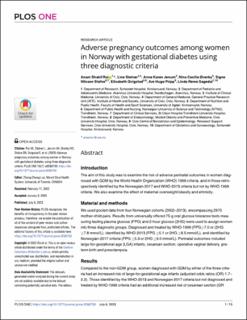| dc.description.abstract | Introduction
The aim of this study was to examine the risk of adverse perinatal outcomes in women diagnosed with GDM by the World Health Organization (WHO) 1999 criteria, and in those retrospectively identified by the Norwegian-2017 and WHO-2013 criteria but not by WHO-1999 criteria. We also examine the effect of maternal overweight/obesity and ethnicity.
Material and methods
We used pooled data from four Norwegian cohorts (2002–2013), encompassing 2970 mother-child pairs. Results from universally offered 75-g oral glucose tolerance tests measuring fasting plasma glucose (FPG) and 2-hour glucose (2HG) were used to assign women into three diagnostic groups: Diagnosed and treated by WHO-1999 (FPG≥7.0 or (2HG ≥7.8 mmol/L), identified by WHO-2013 (FPG ≥5.1 or 2HG ≥8.5 mmol/L), and identified by Norwegian-2017 criteria (FPG ≥5.3 or 2HG ≥9.0 mmol/L). Perinatal outcomes included large-for-gestational-age (LGA) infants, cesarean section, operative vaginal delivery, preterm birth and preeclampsia.
Results
Compared to the non-GDM group, women diagnosed with GDM by either of the three criteria had an increased risk of large-for-gestational-age infants (adjusted odds ratios (OR) 1.7–2.2). Those identified by the WHO-2013 and Norwegian-2017 criteria but not diagnosed and treated by WHO-1999 criteria had an additional increased risk of cesarean section (OR 1.36, 95% CI 1.02,1.83 and 1.44, 95% CI 1.03,2.02, respectively) and operative vaginal delivery (OR 1.35, 95% CI 1.1,1.7 and 1.5, 95% CI 1.1,2.0, respectively). The proportions of LGA neonates and cesarean section were higher for women with GDM in both normal-weight and overweight/obese women. Asians had a lower risk of delivering large-for-gestational-age infants than Europeans applying national birthweight references, but maternal glucose values were similarly positively associated with birthweight in all ethnic groups.
Conclusions
Women who met the WHO-2013 and Norwegian-2017 criteria, but were not diagnosed by the WHO-1999 criteria and therefore not treated, had an increased risk of LGA, cesarean section and operative vaginal delivery compared to women without GDM. | en_US |

